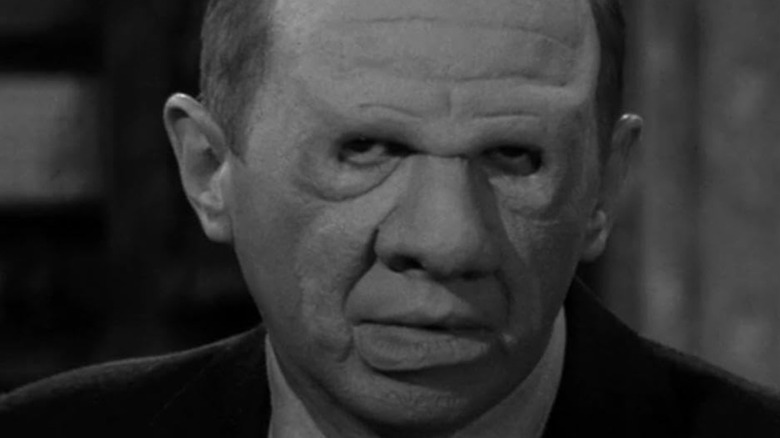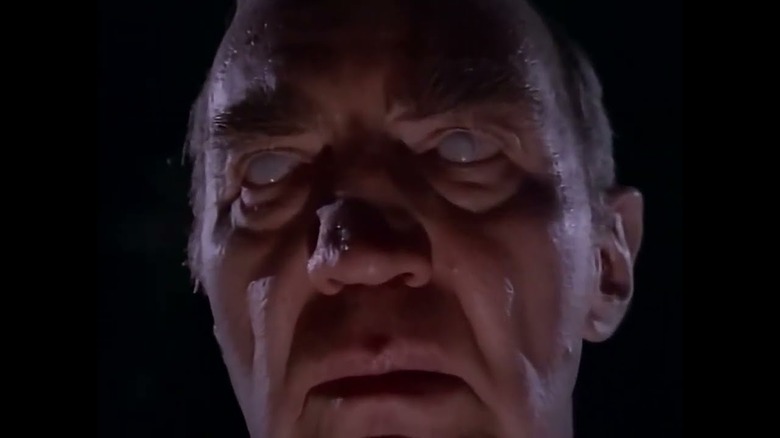The Scrapped Twilight Zone Episode That Was Deemed Too 'Grotesque' For TV
Rod Serling's "The Twilight Zone" has likely inspired more nightmares than any other TV series in history. Several of the show's notorious twist endings often revealed horrors and grotesquerie typically not seen on the airwaves in the late '50s and early '60s, leaving younger viewers rattled and afraid.
The above image, from the episode "The Masks" (March 20, 1964) came at the end of an episode where a quartet of greedy gold-diggers were forced to wear personality-based masks by the rich patriarch they hoped would die. The patriarch does indeed die, but when the characters remove their masks, they find their faces have mutated underneath. That one kept this author up a few nights.
Other scary faces popped up all across "The Twilight Zone." Many might immediately think of the episode "Eye of the Beholder" (November 11, 1960), which was wholly a close-up of a young woman (Maxine Stewart) waiting to remove her bandages after extensive cosmetic surgery. At the end of the episode, she removes her bandages, and the off-screen doctors announce that the procedure was a failure, which is shocking, as she looks like the gorgeous Donna Douglas. The camera then pulls out and reveals that everyone else has weird, outsize facial features. Beauty, Rod Serling intones, is in the eye of the beholder.
It seems that "Twilight Zone" writer/producer William Froug once pitched an idea for an episode of "The Twilight Zone" that also featured people with mutated faces, but it was considered too weird and gross even for the typically disturbing show. Froug hoping to tell a metaphorical tale about prejudice and symbolic blindness, but his visuals would be too strange to actually visualize in real life. The story of the lost episode was discussed in Marc Scott Zicree's indespensible book "The Twilight Zone Companion."
Many, Many Monkeys
Froug's episode was to be called "Many, Many Monkeys," and was meant to be an allusion to the Three Wise Monkeys maxim that finds its origins in 8th-century China. Of the three monkeys, one covered its eyes, one its ears, and one its mouth. See no evil, hear no evil, speak no evil. The original maxim was meant to encourage the eradication of evil thoughts from mind and deed, but in the modern world, the maxim implies a deliberate ignoring of evil in the world, a quest to remain ignorant.
"Monkeys" was about a nuclear disaster that triggers a bizarre facial condition in the world's population. Flaps of flesh would melt down from people's foreheads and cover their eyes, rendering them blind. There were to be several lines of dialogue about how humans' physical blindness was meant as a symbol for their inner hate, their inability to "see" others. Makeup was not designed for the episode, but one can picture the 1960s-era special effects that would have been required.
Froug did sell this script to the company, but it was shelved. Froug said: "I think they had the feeling it was too grotesque."
For the "Twilight Zone" revival in 1989, however, Froug's script was brushed off.
"Monkeys" was, it seems, a medical drama about a patient (Karen Valentine) afflicted with cataracts. She declares that her blindness is not biological, but divine. The blindness eerily spreads to the world. There is eventually a biological explanation — it's a spreadable bacteria — but Valentine still insists it's God's punishment. The episode ends with Valentine revealing her blindness to be psychosomatic.
As one can see, the blindness effect was achieved with "milky" contact lenses, not flesh blobs. It's unsettling, but not horrifying. Perhaps "Monkeys" wasn't so grotesque after all.

